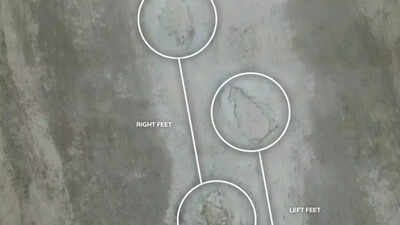Earth was home to huge and enormous dinosaurs millions of years ago. Recently, palaeontologists have uncovered an incredible discovery of a long dinosaur trackway which was preserved under rock and sediment for about 166 million years. Researchers have found hundreds of footprints including those of long-necked plant-eating Cetiosaurus and the carnivorous Megalosaurus. These trackways unveils how dinosaurs walked, interacted and behaved giving scientists a rare glimpse into their daily lives. Apart from this, the footprints discovered also revealed moments when dinosaurs paused, turned and walked steadily along the path. This incredible discovery allowed scientists to follow in the footsteps of these ancient giants and clarify better understanding of the Jurassic world where they lived.
Oxford quarry reveals 166-million-year-old dinosaur tracks of giant Jurassic creatures
As BBC reported, palaeontologists excavated Dewars Farm Quarry in Oxfordshire, uncovering one of the longest continuous dinosaur trackways ever found in the world this summer. Hidden beneath tonnes of limestone, these footprints reveal the movement patterns of massive sauropod dinosaurs that lived approximately 166 million years ago.Emma Nicholls from Oxford University’s Museum of Natural History describes the find:“These footprints are insanely big. They belong to a massive sauropod dinosaur, probably Cetiosaurus, a species previously identified in this area.”Cetiosaurus was a long-necked, four-legged herbivore, capable of reaching 18 metres in length. Visual comparisons show it towering above humans and buses alike, illustrating the sheer scale of these prehistoric giants.
How palaeontologists reveal ancient dinosaur footprints
Dewars Farm Quarry has long been associated with dinosaur research. Initial trackways were discovered in the 1990s, and in 2024, researchers reported 200 enormous footprints scattered across the quarry floor. This year’s excavation revealed even more tracks in a new area, stretching 220 metres, making it one of the longest continuous dinosaur trackways known.University of Birmingham palaeontologist Kirsty Edgar highlighted the significance: “We’re uncovering something unprecedented. Trackways of this size are extremely rare.” Excavating such a vast site requires both power and precision. Controlled explosions remove millions of years of limestone rock, giving palaeontologists access to the delicate fossilised footprints.Once exposed, each impression is meticulously uncovered using trowels, brushes, and buckets. Among the quarry’s multiple trackways, one path—dubbed the “dinosaur superhighway”—extends almost continuously across the site. Each footprint contains a small forward bump, showing the direction the dinosaur’s foot pushed through the prehistoric mud. This provides vital clues about the dinosaur’s movement.
Dinosaur footprints reveal predator behaviour in Jurassic Oxfordshire
Smaller tracks discovered by Megalosaurus are two-legged carnivorous dinosaurs reaching up to 9 metres long alongside the massive sauropod footprints.These are the three-toed footprints revealing predator behaviour and adding further detail to the Jurassic ecosystem of Oxfordshire. Footprints offer insights into dinosaur behaviour that skeletal fossils alone cannot provide. Peter Falkingham of Liverpool John Moores University explains:“With a skeleton, we can estimate stride length. But trackways show hundreds of metres of natural movement, revealing how dinosaurs walked, interacted, or paused.” Trackways can indicate whether dinosaurs moved alone or in herds, or if they were fleeing predators or wandering leisurely. They are critical in reconstructing behaviour, informing both science and cinematic depictions, like those in Jurassic Park.Using the trackways, Prof Falkingham has built a 3D model of the Cetiosaurus. His analysis shows the dinosaur walked at around two metres per second, similar to a human walking briskly.Also Read | Spider-tailed horned viper: The incredible Iranian snake that tricks birds with a moving spider tail






